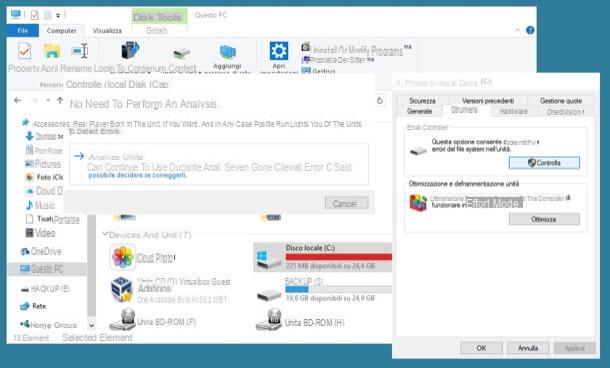Correct storage of magnetic storage media
(Hard Disk, Floppy Disk, Tape Cartridge, Magneto-optical disks, et similia)
Magnetic devices and common problems
The computer storage devices based on magnetic media can keep data for a very long period of time (typically, it is estimated some tens of years) without deteriorating and / or deleting the information contained in a significant way. However, in order to obtain optimal performance and prolong their life as much as possible, it is necessary to follow some guidelines of behavior in the preservation and storage of the devices.
Attention: The following indications are drawn up taking a "hard disk" as reference support, but they can be extended, as regards the logic, mechanical and magnetic part, to all magnetic storage devices. The indications on the logical part can be extended to any storage device, including devices based on flash memories, that is solid state.
First you need to consider problems that can run over the device e events responsible, in order to prevent these conditions:
- Logical damage: logical damage is related to the logical structure of the disk, ie the organization of data within the device. They may be due to operating system malfunctions, in the intervention of virus o malware, but much more often they are due to human error during use, such as the voluntary and sudden restart of the system, by pressing the "reset" button, or its shutdown by disconnecting from the mains.
- Electronic damage: in most cases, electronic damage affects the electronic board present in the hard disk, and in rarer cases also heads and motor.Damages of this kind are often evident: smell of burning, or obvious burns, are the most evident signs ; however, sometimes the damage can be located in very small or invisible areas: in this case, it is necessary to pay attention to the symptoms. Frequent symptoms are the total absence of activity in the device correctly powered and connected, or specific malfunctions, such as not being detected by computer. Moisture or water can also lead to irreversible damage of this type. In particular, conditions may arise in which the currents also spread to points on the logic board where they should not be present. This condition leads to delicate components, such as microprocessors or controllers, to become damaged. Damages of this kind are often due to atmospheric causes, such as the presence of elevated electrostatic charges that are downloaded to the device itself, power surges, adverse weather conditions environmental. However, a human error: overcharging of the hard disk, polarity inversion, electrostatic charges accidentally introduced into the device, or water accidentally spilled on it (or worse, coca-cola or other liquids).
- Mechanical damage: In most cases, mechanical damage affects the internal mechanical part of the hard disk, and in rarer cases, also its electronic board. Damages of this kind are often not evident without powering the device and without trying to use it. They are almost always due to bumps or falls accidents of the device, and are more serious if they occur while the device is in operation. They are therefore often derived from human error, although to a small extent they may be due to manufacturing defects or problems with the computer's remaining hardware (for example, an off-axis fan causing very strong vibrations).
- Magnetic damage: magnetic damage mainly affects the magnetic platters in which the data is stored. High magnetic fields can irreparably damage hard drives, rendering them in the vast majority of cases unusable. It goes without saying that the stored information is totally destroyed. Exposure to strong magnetic fields, in particular impulsive, is one of the techniques used for secure erasing procedures, and are called degaussing techniques: these techniques compromise in a way the magnetic surface of the devices is irremediable, destroying the information and rendering them practically inert.When the magnetic damage is not voluntarily caused, it is often due to unintentional exposure to strong fields, coming for example from permanent magnets (such as those of loudspeakers in loudspeakers acoustic) or electronic devices that emit powerful magnetic fields (from transformers to electromagnets). In this regard, it should be remembered that each conductor of electricity generates a magnetic field around itself, since the magnetic field is nothing more than a relativistic correction of the electric field. What varies, however, is the intensity of the field itself, and only fields with an intensity greater than a dozen gausses, located relatively close to it, can create permanent and irreversible damage to a hard disk.

Notes on conservation
- When storing the device, to prevent logical damage it is essential, when operating on the device, to use it in the READ-ONLY, so as to make it impossible to accidentally write the device. This mode is easily obtained in a Linux environment, by mounting the device using the “–ro” (read-only) flag.
- To prevent electronic problems, it is essential to protect it as much as possible from events, both accidental and environmental, which could compromise its electrical functionality. A little caution is often enough to protect it from liquid, while to protect it from electrostatic charges it is necessary to use antistatic bags and provide for download the charges accumulated in your body on the ground before operating on a hard disk. In most cases it is sufficient to touch a grounding point (such as the metal of a radiator) to discharge the static electricity accumulated in the body.
- To prevent mechanical damage, a little bit of is often sufficient caution. If it is not possible to prevent damage related to the normal mechanical wear of the devices, it is possible to prevent them from suffering bumps or falls accidental, by storing them, for example, on stable surfaces free from vibrations or oscillations, due both to human intervention and to particular environmental conditions (for example an earthquake).
- Prevention of exposure a magnetic fields finally, it is fundamental. In this regard, it is necessary to remember that both the intensity of the field and the distance of the storage device from it are important. The magnetic field is invisible and intangible, but its very nature implies that there are starting and ending points of the field lines: not being able to eliminate it materially, it is necessary to ensure that these lines are deviate as much as possible from the unwanted destination (the disk). This can be achieved by isolating it by means of ferromagnetic material, so that the lines of the field bend so as to thicken inside the material with the highest permeability.

The effectiveness of such shielding it depends on the magnetic permeability, as well as on the thickness of the shielding wall. The materials developed for this specific function are special alloys subjected to particular heat and metallurgical treatments. It should also be remembered that a magnetic material, when it is removed from the field, tends to retain the magnetic energy induced on it, behaving like a permanent magnet with a certain coercive force. The alloys designed to produce magnetic screens, in addition to having a high magnetic permeability, are also optimized for having a low coercive force.
However, the cost of such screens is often prohibitive. At the same time, their availability is difficult. Often therefore it is preferred to keep as far as possible hard drives from magnetic fields, although this solution represents a cost / benefit compromise.
Conclusions
Based on the above, a hard drive should be kept:
- In an environment as free from humidity as possible
- Protected from liquids that could accidentally run over it
- Isolated as much as possible from magnetic fields, both continuous and impulsive
- Isolated and protected from electrostatic charges
- Used in "read only" mode only
Consequently, in the storage optimal solutions are:
- Inserting the hard disk into antistatic bags
- The use of sachets of silicates, which absorb moisture, inserted inside the aforementioned envelopes together with the hard disk
- Conservation in stable shelves
- Keep them at anheight such as to protect them from any flooding of the room
- Store them in a well room protected from atmospheric agents (water and temperature changes)
- Keep them at anheight such as to allow a comfortable one handling and avoid accidental falls
- Coat the disc further with packaging material (eg nylon with bubbles, etc.) so as to avoid abrupt vibrations
- When used, first discharge static electricity to the ground accumulated in the body and, if possible, use a grounded metal bracelet to keep the potential difference low.


























